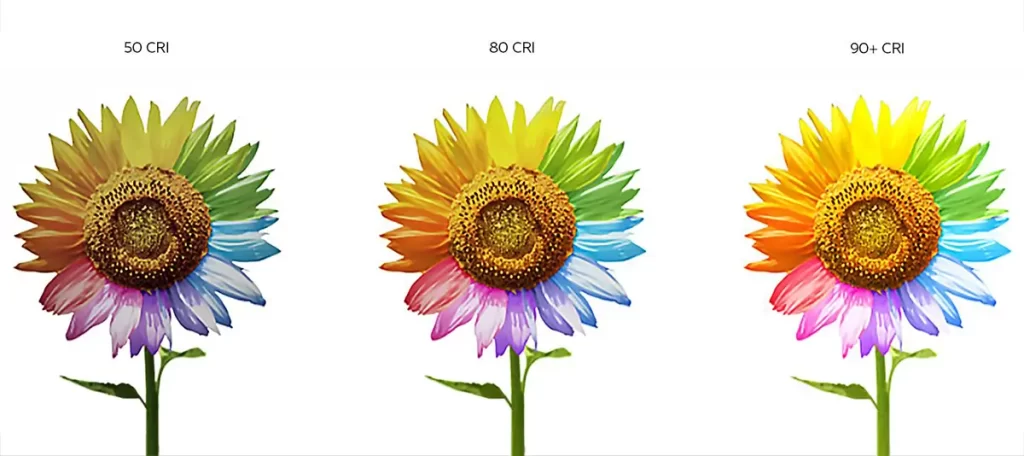
When we choose the color temperature, we also need to pay attention to special data. That is the Color Rendering Index (CRI). Color Rendering Index (CRI) is an often-overlooked indicator of color quality. Also, for any application where color appearance is important, CRI considerations are critical. CCT measures the actual color of light produced in Kelvin and has nothing to do with the lighting accuracy of the light. In this article, we will explain what CRI is, the importance of CRI, and its application of CRI.
What is the Color Rendering Index (CRI)?
Color Rendering Index (CRI) is a measure of the ability of a light source to accurately reproduce the color of the object it illuminates. The special application Light sources with high CRI. In fact, this is complex content. We explain it in two levels:
Color Rendering Index (CRI) for Measuring Artificial Light Sources
Light sources can be classified as artificial light sources or natural light sources. We are all particularly concerned about the color quality of artificial lighting forms such as LED lamps and fluorescent lamps. This is similar to daylight or sunlight – a natural light source.
Color Rendering Index (CRI) Highest Index is 100
As far as LED strip lights are concerned, the CRI is an indicator of quality for it because it is expressed as a single quantitative number. There are CRI80+, CRI90+, and CRI95+ options for them, and the larger the number, the higher the capacity. There are many clients who consider a CRI score of 95 and above to be excellent, while scores below 80 are generally considered poor.

Color Rendering Index (CRI): Natural Light vs Artificial Light
Natural light, such as sunlight, is a combination of all colors in the visible spectrum. The color of sunlight itself is white, but the color of an object in sunlight is determined by the color it reflects.

When we use LED lights for lighting, we want to reproduce the color of natural daylight so that the color of the object appears to be the same as it would be under natural light. Sometimes the reproduced colors look very similar, other times they are completely different. It is this similarity that the CRI measures.

We can see that LED lights and natural daylight have the same 5000K color. This means that the light is the same color, but objects still look different. How can this be?
So you will find that our LED lights have a different spectral composition compared to natural daylight, even though it is the same 5000K white. Especially our LED lights lack red. When this beam of light bounces off the red apple, no red light is reflected.
CRI is intended to express the following phenomena by measuring the general accuracy of the color of various objects under the illumination of light sources.

Which CRI Ranges to Use?
Regarding the choice of CRI, this also depends on different needs. We recommend LED lighting CRI over 90, but if it is a general lighting project, a minimum of 80+ is also acceptable. Below is a brief description of the scope of the CRI:
CRI 95 – 100 → Excellent color rendering. Products will come out as they are, skin tones will look beautiful, and art will come to life.
CRI 90 – 95 → Excellent color rendering! The color will also look rich and look nice and vibrant.
CRI 80 – 90 → Good color rendering, most colors can be rendered, mainly for domestic and commercial use.
CRI below 80 → Lighting below 80 has poor color rendering. As a result, the color underneath the item looks desaturated and flat.
How About Testing CRI?
- The Lighting Research Institute report also recommends the combined use of the TM-30-20 Gamut Area Index. These additional measurements are Color Quality Scale (CQS), and IES TM-30-20 including Gamut Index, Fidelity Index, Color Vector.
- CRI – Color Rendering Index – How closely the observed light can render colors like the sun, using 8 color samples.
- Fidelity Index (TM-30) – How closely the observed light can render colors like the sun, using 99 color samples.
- Gamut Index (TM-30) – How saturated or desaturated colors are (aka how intense the colors are).
- Color vector Graphic (TM-30) – Which colors are saturated/desaturated and whether there is a hue shift in any of the 16 color bins.
- CQS – Color Quality Scale – An alternative to the unsaturated CRI measurement colors. These 15 highly saturated colors compare chromatic discrimination, human preference, and color rendering.
Why the CRI Is Important?
Mainly because CRI is an important indicator of the performance of artificial lamps. And is a key purchasing consideration in today’s lighting market. Most people already recognize the important benefits of using lights with a higher CRI rating. At present, most customers will choose CRI90 or above, and some customers will choose CRI80 or above. But below 80, basically, no customers will choose.

How to Choose the Suitable CRI for Your Light Project?
For most indoor lighting and commercial lighting, CRI80 is actually acceptable. But we all suggest that customers choose CRI90 or above will be better. Because of the high CRI for applications where color appearance is important for interior work or helps to improve aesthetics.
There are also many special places that need to use CRI90 or more, such as hospitals, high-end hotels and retail stores, residences, and photography studios. When comparing lighting products with CRI values above 90, it is helpful to compare the individual R-values that make up the CRI score, especially CRI R9.
Conclusion
- For color, CRI is an important factor to consider.
- Higher CRI values generally indicate better color rendering properties.
- Choose the appropriate CRI according to your own needs, and consider the R9 value.
- Color Rendering Index (CRI) is a measure of the color rendering ability of a light source compared to a reference light source.
FAQs
CRI refers to the evaluation of the color reproduction and color accuracy of an object under different artificial lighting conditions. The CRI uses a numerical scale from 1 to 100 and compares it to how those objects would look in natural sunlight
Generally speaking, a CRI of 80 is sufficient, and of course, a CRI value of 90 and above is generally considered excellent.
For special applications, stick to a CRI between 95 and 98.
That is of course CRI100, which is close to the standard of natural light because sunlight shows the true color of objects.
CRI80 and CRI90 are normal, the CRI95 is special now.
